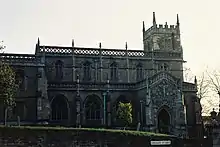Church of St Peter and St Paul, Wincanton
The Anglican Church of St Peter and St Paul in Wincanton within the English county of Somerset is a Grade II* listed building.[1] The Church of St Peter and St Paul was almost totally rebuilt 1887-91 by J. D. Sedding, however parts of the tower may be remnants form an earlier church, dating from 1313, on the same site.[2]
| Church of St Peter and St Paul | |
|---|---|
 | |
| Location | Wincanton, Somerset, England |
| Coordinates | 51°03′18″N 2°24′49″W |
| Rebuilt | 1887-91 |
| Architect | J. D. Sedding |
Listed Building – Grade II* | |
| Designated | 24 March 1961 |
| Reference no. | 1238534 |
 Location of Church of St Peter and St Paul in Somerset | |
History
Little of the original church remains but it is known that in 1748 Nathaniel Ireson, a local architect built and paid for a new chancel, which has been removed in subsequent renovations, and carved several of the memorial tablets.[3] In 1793 the tower was raised by 12 feet (4 m) making it 50 feet (15 m) high, five bells were cast and a sixth added.
Because of the state of the roofs, which are under repair, the church is included on the Heritage at Risk Register.[4]
Architecture
The stone building has almost flat lead roofs behind parapets. It consists of a nave, chancel, north aisle and a double width south aisle, organ chamber, lady chapel, and north porch. The porch which was built in 1891 has a Calvary scene above the arch. The three-stage tower is supported by diagonal offset buttresses and a corner stair turret. The east window has stained glass by Clayton and Bell which was installed in 1889.[1]
Churchyard
The churchyard includes a self designed and carved monument to Nathaniel Ireson who died in 1769.[3][5] The statue in 18th century costume faces south west and stands on a square plinth inscribed to Nathanial Ireson and his family.[6] The pedestal has been replaced since the original statue was erected.[3] Another memorial, erected early in the 19th century is to Elliot Grasset Thomas and his family. Only the plinth with his coat of arms survives from the original structure.[7]
The stone walls and gateways around the churchyard were built in 1818. The north east gateway is the largest of several entrances to the site.[8]
References
- Historic England. "Church of St Peter and St Paul (1238534)". National Heritage List for England. Retrieved 4 April 2015.
- "Church of St Peter and St Paul". historicengland.org.uk. English Heritage. Retrieved 16 October 2008.
- Byford, Enid (1987). Somerset Curiosities. Dovecote Press. p. 14. ISBN 0946159483.
- "St Peter and St Paul, Church Street, Wincanton — South Somerset". Heritage at Risk. English Heritage. Archived from the original on 22 October 2013. Retrieved 19 October 2013.
- "The Nathaniel Ireson Monument". Somerset Historic Environment Record. Somerset County Council. Retrieved 17 October 2008.
- Historic England. "The Nathaniel Ireson Monument, 4 metres South East of Chancel, Churchyard of St Peter and St Paul (1274132)". National Heritage List for England. Retrieved 4 April 2015.
- Historic England. "The Thomas Memorial, 22 metres East of Chancel in Churchyard, Church of St Peter and St Paul (1238555)". National Heritage List for England. Retrieved 4 April 2015.
- Historic England. "The Churchyard gates and boundary walls to North and West, Church of St Peter and St Paul (1238554)". National Heritage List for England. Retrieved 4 April 2015.
